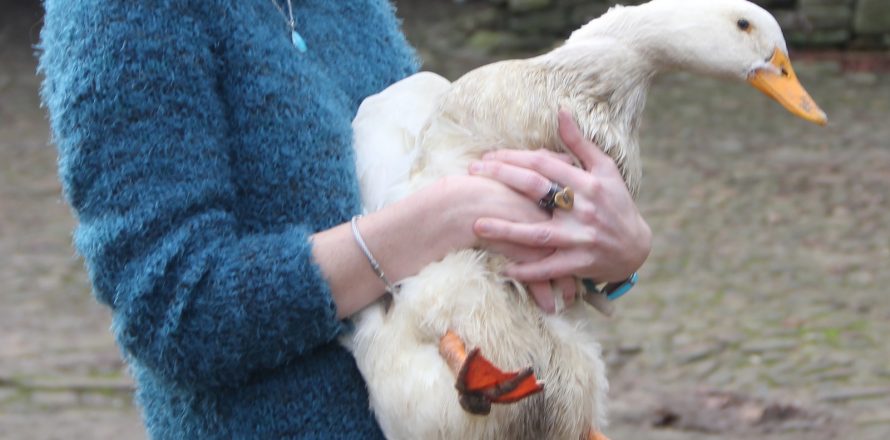Hannah and her husband Paddy are the proprietors of Roundwood House, a 270 year old Georgian mansion that they run as a guesthouse, with regular overnight visitors and wedding functions as part of their weekly routine. There have always been poultry on the homestead, waddling, clucking and quacking in the cobbled yards around the house. The small collection of ducks and hens may not produce many eggs, but visitors to the house enjoy their quirky characters.
Hannah bought Ailie along with three other ducks at Portlaoise Poultry Market three years ago. They were young birds, and she kept them in an enclosed herb garden for the first few months of their life. When they were big enough to look after themselves, they joined the other birds – Muscovy Ducks and hens – and began to live free range lives, roaming the land around Roundwood House. Hannah always locks the birds safely in a shed at night: the fox is a continual threat during the hours of darkness.
A couple of months ago, Hannah noticed that Ailie was limping on her right leg. When she looked closer, she could see that the foot had a lumpy appearance on the underside. At first she thought that it might be a minor injury that would resolve with time, but when it seemed to be getting worse rather than better, Hannah asked me to have a look.
It’s common for ducks to have problems with their feet. They are virtually flightless birds when kept in farmyards, and they have large, heavy bodies, so their feet carry a lot of weight, putting them under pressure. Ducks like to walk in wet, muddy areas with irregular surfaces, so it isn’t surprising that their feet are sometimes damaged. When I examined Ailie’s feet, they seemed generally healthy, apart from the obvious cauliflower-like appearance of warty growths sprouting beneath her toes. There are a number of possible causes of these type of growths in birds. I used a scalpel blade to take a skin scraping from her feet to check for a parasite known as the Scaley Leg Mite. These mites are common, spreading easily between birds, and once they have been identified, they can be easily treated. I checked the skin scrape under a microscope, and I was disappointed when I couldn’t find any mites: I had wanted to find a simple problem that I could cure.
Once mites had been ruled out, the other causes were more complicated and less easy to sort. Ideally, a full surgical biopsy could be taken: this could be sent to the laboratory to be processed, and would provide a definitive diagnosis. However biopsy collection would require an anaesthetic, it would be expensive, and it would be very unlikely to change the treatment and outcome for Ailie. It’s very likely that the lumpy growths are warts, which can happen spontaneously, but they can also be caused by viruses. There is no quick cure for them: the best that can be done is for Ailie to be kept in a sheltered area, with soft, dry bedding underfoot rather than the usual wet and mud that ducks enjoy waddling around in. In time, with good nutrition and a bit of luck, her immune system will eradicate the virus that is the most likely cause of the problem.
She now lives in a small yard with a couple of her feathered friends. Regular loads of fresh, dry straw keeps their area clean and dry, and Hannah regularly checks Ailie’s feet to ensure that there are no sore areas where the warts are protruding. Ailie must now be the most pampered duck in County Laois.
TIPS
- Ducks often suffer from problems affecting their feet
- Parasites like mites can be easily treated and cured
- Dry, soft bedding is helpful for all foot problems in poultry

